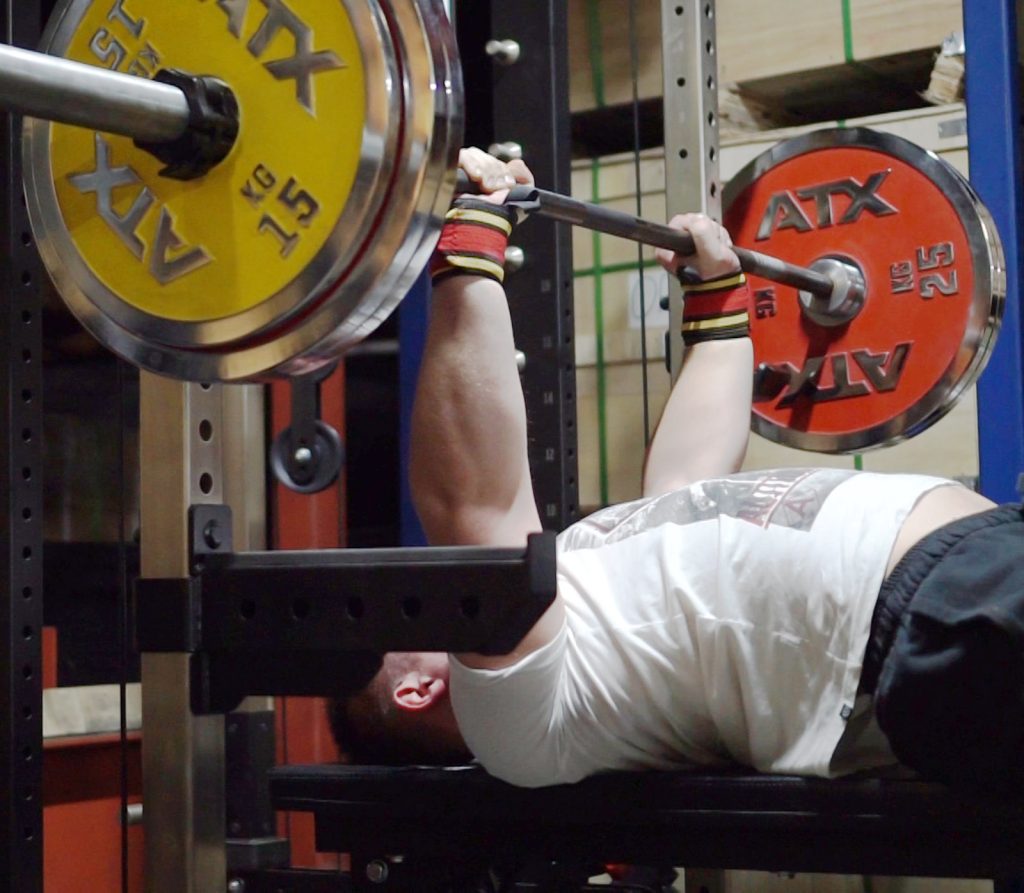Close Grip Bench Press
I’ve heard that if you want to bench more you have to bench more often. That is partly true. If you want to have bigger bench press you will have to perform different variations of it. Close grip, medium grip, wide grip and even flat, incline or decline. That’s a lot of pressing!
Close grip bench press is essential for a bigger bench press. It focuses on triceps which will help you to lock out the lift. So for example if you get stuck at around 2/3 of the lift I would recommend adding close grip bench press as one of your accessory exercises.
Don’t go too wide or too narrow on your grip, anything wider than your shoulders will shift the load towards your chest, anything closer will put unnecessary strain on your wrists without any additional benefit for your triceps. Optimum grip leads to optimum muscle growth.
There are plenty of videos online showing you how to bench press with a close grip. I had a look at a few of them before writing this article. What I’ve noticed is that the weight on the barbell in most of the videos was about 60kg. But they were using a very close grip.
The theory behind this is that the triceps are more isolated. But there is a downside.
If you’ve been training for a while you can easily get away with a very close grip. But I wouldn’t recommend it for noobs. As I mentioned it does not give you any extra triceps activation but puts unnecessary stress on your joints (wrists and elbows).
A very close grip works great with lower weights, but once you will put a few more plates on the barbell, you will notice the discomfort straight away. Our aim is to develop stronger triceps, not wrist injuries. With a wider grip you can use heavier weight, which will create the additional stress on the triceps, but not on the wrists or elbows.
I would not recommend jumping to heavy weights straight away. First of all, the movement is going to feel awkward for the first few weeks until your body adjusts. Secondly you don’t know what you can lift since you’ve never done this exercise correctly. Start low and then slowly increase the weight over the coming weeks.

The Proper Form for Close Grip Bench Pressing
1. Grip Position.
I personally grip the bar a bit wider than the shoulder width, I find it to be the most comfortable position. But don’t take my word for granted, each of us is built differently and you will have to find your own perfect position. If you listen to your body you will get optimum results and avoid any potential injuries.
Another consideration is my normal bench press grip is wider than most. So, although my close grip position is a bit wider than shoulder width, it is significantly narrower than my normal grip.
2. Elbows.
Do not tuck your elbows too close to your chest. That will put too much stress on your elbows. Also it takes us to a movement that is too far away from the normal bench press path or groove.
3. Feet Position.
Never place your heel in front of your knee, try to have the heel a bit back, this will give you proper leg drive. It will also build more tension in your arch.
A strong foot position will create stability over your whole body and enable you to lift more weight.

4. Arching
Just like in the regular bench press you will have to arch. Arching will give your rotator cuffs slightly more room to move around.
To do this you just tuck your shoulder blades together and arch back
5. Benching Close Grip Style.
Now since you know how to set up you can move to benching. It will take you a few sets to find the optimum position for your body.
– Unrack: Once you “unrack” the barbell, prepare for the lift: breath in, tense all your body and slowly lower the barbell down.
– Placement: Bring the barbell down to around middle of your chest. Again you will have to find the most comfortable position for you.
– And up: Bring the barbell up, do not forget leg drive, and try to recruit as many muscles throughout your body while maintaining correct form.
– Breathing-:Breathe out once you finished the movement and locked out your elbows. Holding your breath in through the whole lift will give you more stability and allow you to handle the weight with ease.
Always listen to your body when training, nobody knows you better than you do. The lifts you see on online is a suggestion to a good lift not a blueprint. If your elbows or wrists are sore from other exercises, lower the weight until you do not feel any discomfort. Lifting heavy weights is fun but sometimes it’s better to go easy as it is not worth the pain which might not disappear for weeks.
Train smart, train hard and always listen to your body!
